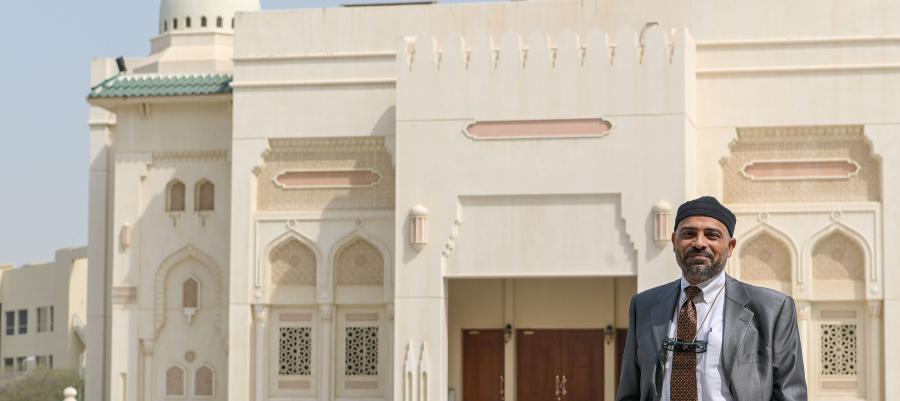- About
- Admissions
- Study at AUS
- Prospective Students
- Bachelor's Degrees
- Master's Degrees
- Doctoral Degrees
- Admission Publications
- International Students
- Contact Admissions
- Grants and Scholarships
- Sponsorship Liaison Services
- Testing Center
- New Student Guide
- File Completion
- New Student Orientation
- Payment Guide
- Executive Education
- Students with Disabilities
- Academics
- Life at AUS
- Research
- Contact Us
- Apply Now
- .

AUS professor improves design standards for sustainable mosques
Seeing an opportunity to reduce the usage of water and energy by Muslims in their daily worship, Dr. Ahmed Mokhtar from the College of Architecture, Art and Design (CAAD) at American University of Sharjah (AUS) has developed improved standards for mosques and public prayer facilities for sustainable outcomes.
From patenting new sanitary fixtures for ablution to developing design guidelines for prayer facilities, Dr. Mokhtar’s research is already making an impact, with Abu Dhabi Mosque Development Regulations implementing some of his recommendations in all new mosques and for the retrofitting of existing mosques. By adopting some of Dr. Mokhtar’s guidelines, the average community mosque can save up to 70 percent of its monthly energy usage.
Canadian-Egyptian with qualifications in architecture, engineering and business, and a special interest in sustainability, Dr. Mokhtar explained that the main prayer hall in a mosque is usually designed to meet the capacity for one hour of Friday prayers, while usually only about 10 percent of its capacity is used during the rest of week. By air-conditioning this largely unused space, a significant amount of energy is wasted throughout the week.
“In the UAE we air-condition our mosques, which is essential in operating in this hot climate. However, in doing so, these buildings use a lot of energy, which is usually paid for either by the government or through donations from the local community. With better design, we should be able to reduce such energy use,” said Dr. Mokhtar.
“In my research, I tested the implication of dividing a mosque into two zones—a large one for Friday prayers or when the building is at full capacity, and a small one for daily prayers. The result is a significant reduction in energy usage, in some cases up to 60 or 70 percent,” he said.
Dr. Mokhtar said the extent to which mosques can reduce their usage of water depends on faucet technology use, government regulation and—mostly importantly—education.
“We can have the best technology and best regulations in place to save water, but if the public is not educated about how and why they should use water in a more economical way, then it all falls apart. Really, these need to work together,” he said.
Further research by Dr. Mokhtar has been published by AUS, establishing the first ever standards to be created for ablution space design. He has also gone on to patent a new sanitary fixture for ablution that is currently under commercial development.
Some of these standards include establishing a “clean zone” within which both the prayer hall and the ablution space are located. This concept ensures that worshipers can perform their ablutions and seamlessly move into the prayer hall barefoot. These standards are being applied in many shopping centers and public buildings and are adapted by Abu Dhabi Mosque Development Regulations.
In the future, Dr. Mokhtar would like to see further improvements in the standards of mosque designs and the quality of their construction. He suggests that establishing a mosque-design library or catalog could be a useful addition to the process.
“In the UAE, most mosque design and construction are funded by individual donors who usually select their own designer and contractors. In many cases, these have never designed or constructed a mosque before. By creating a not-for-profit mosque-design library including detailed construction drawings, individual donors and their contractors could simply select the design that works for them and have all the plans they need to easily move their project forward,” said Dr. Mokhtar.
Earlier this year, AUS announced the development of its own Climate Action Plan with the goal to reduce the university’s carbon emissions in line with the UAE’s Net Zero by 2050 strategic initiative. Dr. Mokhtar joins other AUS faculty in working towards research that will make an impact on how the UAE and the university can meet their sustainability goals.
For more information about AUS’ commitment to a sustainable future and more examples of research by our world-class faculty, visit www.aus.edu.

